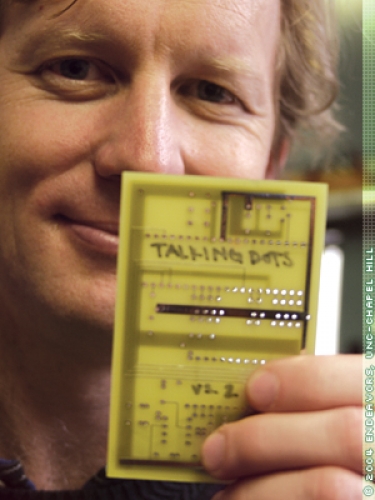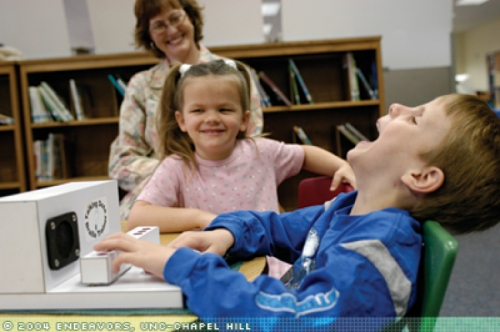A toilet flushes, and two children dissolve into giggles.
Kindergartners Brooklyn and Bobby aren’t just indulging in a little potty humor at school. They’re learning Braille. The toilet sound helps them master t, one of the most difficult letters, says Diane Brauner, an orientation and mobility specialist who works with students with visual impairments in North Carolina public schools.
A Braille training device called Talking Dots makes the sound. Talking Dots, designed by Carolina biomedical engineering graduate students Randal Cole and Arielle Drummond, has six dime-sized buttons representing the dots of a Braille cell. When a student presses the buttons that form a letter, they pop up. The device announces the letter and plays a corresponding word and sound.
Since Braille is produced differently than it is read, the buttons are arranged on two moveable arms. The arms can form either one horizontal row of six dots — an orientation that matches the keys on a Braille typewriter — or two vertical columns of three — the way a Braille cell is read.”It’s good for them to have a spatial feel for what the letters are like,” Cole says. Students then translate that knowledge to the smaller dots of written Braille, learning to produce Braille in conjunction with reading it.
Talking Dots had its genesis in Brauner’s car. “I have a unique job because I go from county to county, so I see the same problems everywhere I go,” Brauner says. “I have a lot of time to think as I drive from place to place.” In the midst of all her driving, Brauner considered the limitations of existing tools for teaching Braille. These tools required too much muscle strength, she felt, or were repetitive and boring to students.
What could make Braille more fun? Brauner proposed the idea for a sound-reinforcing Braille trainer to Richard Goldberg, assistant professor in the biomedical engineering department of the School of Medicine. Goldberg teaches a class each year in which students develop custom devices to help people with disabilities. Drummond and Cole, students in Goldberg’s class, took the assignment and ran with it, pilot-testing Talking Dots in a Durham County elementary school last spring. “It’s a very motivating toy,” Drummond says. “The kids learn the letters because they like the sounds it makes.”
Since last year, Brauner has used the device in classrooms across the state. “A lot of teachers have seen it, and a lot of kids have played with it,” she says. “Every teacher I’ve shown it to has said, ‘I want one.’” And the Rehabilitation Engineering and Assistive Technology Society of North America chose Talking Dots as one of this year’s winners of its student design competition.
Goldberg teaches his design class with Kevin Caves, a rehabilitation engineer at Duke University. The course is a joint effort between the two universities and meets by teleconference. “We want students to have an experience designing something,” Goldberg says.
Students, both undergraduate and graduate, construct circuits, program computer chips, and install wiring and switches. They work with therapists, teachers, clients, and families along the way to guide their projects’ safety and effectiveness. Sometimes they build from scratch and sometimes they work with what’s already there. “Often there are commercial devices that exist that aren’t quite right, and what we’ll be doing is making something a little bit different that’s more appropriate,” Goldberg says.
To find clients and project ideas, Goldberg and Caves use their contacts with schools, organizations, and private therapists. “People really enjoy working with the students and going through the whole development of the projects,” Goldberg says. And the designers donate finished devices to their clients. “They’re always shocked,” Goldberg says. “‘You mean you’re going to give this to me?’”
In the last few years, clients have gotten to keep a variety of toys. An eight-year-old girl with limited muscle control due to cerebral palsy gets around independently in a modified Barbie Jeep — a kid-sized electric car — outfitted with a joystick and a supportive seat. A device called The Sound Wall helps a three-year-old who has cerebral palsy strengthen her upper body as she reaches for handlebars, cords, and levers that trigger music, light, and other sensory stimulation. For another eight-year-old who has cerebral palsy, hearing, and visual impairments, students designed a Sensory Play Gym that fits around the girl’s side lyer — a product that supports her in a reclining position on her side — and contains switches, toys, and textured materials.
And it’s not always kid stuff. Duke students in the class are currently working on projects including a support device for a dancer with a weakened left leg, a Morse code training device for a man whose arms and legs are paralyzed, and a modified darkroom for a professional photographer whose right arm was paralyzed in an accident.
This year, Carolina students are developing two tools to help adult employees of Orange Enterprises, a Hillsborough, N.C., nonprofit that employs people with physical and cognitive disabilities. Orange Enterprises employees often perform repetitive jobs for which they are paid by the piece. They are perfectly capable of doing their assigned tasks but have trouble keeping track of how many units they’ve completed.
John Dumas, a biomedical engineering graduate student, and Blair Roszell, an undergraduate applied-sciences major, are developing a device similar to a coin counter with an infrared sensor and a lighted display to help employees count and collect small items such as blocks for packaging in teacher kits. And Sirin Yaemsiri and Ken Bradley, both undergraduate applied-sciences majors, are working on an audible counter with a button for employees to press each time they stuff an envelope or perform a similar task. In addition to announcing the current item count, the machine provides audio encouragement — especially important for people with autism, Yaemsiri says.
“It’s amazing to have these ideas floating around, and then suddenly it’s a real object,” Brauner says. She also works with Gary Bishop, associate professor of computer science, whose students develop assistive technology projects as well.
Assistive technology is a relatively new interest of Bishop’s, but one about which he is passionate. “As computer scientists, so much of what we do is very nerdly and off by ourselves,” Bishop says. “I’ve got students who need programming challenges and need to get connected to the real world, too. It means a lot to them to see the kids they’re helping.” His students base their projects around free software they design and existing commercial products anyone can buy easily and inexpensively.
Because of early connections he made with Brauner and with Jason Morris, a Carolina classics graduate student who is visually impaired, much of Bishop’s work to date has focused on helping people with visual impairments. One of his first (and ongoing) team projects, BATS, involves students working with Morris to make maps useful for people who are visually impaired. (See Endeavors, Winter 2003, “Maps for the blind.”)
Working with Brauner, Bishop and his students recently launched a computer game, Hark the Sound, for students with visual impairments. Encouraged and rewarded by fun audio feedback, students use the computer’s arrow keys to respond to multiple-choice questions in categories such as numbers, musical tunes, and Braille. The game is available online, at www.cs.unc.edu/Research/assist/, or on CD. Kids love it, Bishop says. And Brauner is excited that now her students who are “mainstreamed” — part of a class of children who don’t have disabilities — have something to do when their class goes to the computer lab.
A team is also working on a traffic-sound simulator to help children who can’t see learn to cross the street. And they’re writing a computer program that will connect to an existing toy, a musical dance floor mat with six sensors, to make a Braille version of the popular Twister game. Children place hands, feet, elbows, and knees on combinations of the six sensors to form Braille letters. They get audio feedback, and they get exercise to build the upper-body strength that, according to Brauner, children with visual impairments often don’t develop.
Two of Bishop’s students, undergraduate applied-sciences majors Christa Wheeler and Sirin Yaemsiri, developed another musical game last year that encourages upper-body strength in a child who has limited vision. Their client, an Alamance County toddler named Victor, could already walk, but they wanted him to crawl, too.
Children with visual impairments often walk first, Yaemsiri says. “It’s a defense mechanism. When you crawl, your head comes first and you’re likely to bump into things. So a lot of kids who can’t see just start walking first, with their hands out in front of them.” Victor’s mother, understandably protective of her son, was also initially hesitant for him to crawl, says Susan Puckett, a teacher of the visually impaired who works with Victor. But if children don’t ever crawl, they may not develop the motor coordination and upper-body strength they need to use a cane and read Braille.
Motor-skill development is also delayed in children until they understand that sound has a physical source. “Kids who can see just look at things and say, ‘What’s that?’ and want to explore,” Wheeler says. “But for visually impaired kids, if no sound is coming, they don’t know what’s there.”
Wheeler and Yaemsiri began their project for a class they took with Bishop and continued work under Goldberg’s supervision. “The final product is professionally done, outside and inside,” Goldberg says. And Puckett says the toy helped Victor spend more time crawling. “His exploration really took off,” she says.
In action, the game spans a living room. Four toys are connected to a central control box by fifteen-foot cables. They’re commercial toys you might find in any child’s home, but Wheeler and Yaemsiri wired and programmed them to play four familiar songs so that, when Victor or one of his parents presses the switch on any of the four toys, one of the toys begins to sing.
When they delivered the game to Victor last fall, Yaemsiri and Wheeler watched him follow the music. “He was attentive auditorily, interested in getting over to where he heard the noise,” Puckett says. Once he reached it, each singing toy itself was a tactile reward he could stop and enjoy. But if he pressed that toy’s switch, a different song began playing from another toy. The music can be set to move through the four toys in ordered or random sequence.
Victor’s family recently moved, and Victor learned his new house quickly. His parents encourage Victor’s natural eagerness to explore. And, Puckett says, “The toy initially helped him to move out to something unknown.” In spite of his limited vision, Victor, now two years old, is “at the age where he wants to go, go, go.”
Wheeler and Yaemsiri also made final modifications to the Talking Dots Braille trainer designed by Cole and Drummond. They switched the speakers and made a new circuit board to improve the sound quality, added a feature for children to record their own sounds, and changed some of the sounds associated with the letters. Among their additions was the infamous toilet flush.
Brauner says, “It’s been really fun for me to see these kids light up when they get to play with these toys and they’re learning what they need to learn.”
Michelle Coppedge was formerly a staff writer for Endeavors.
Goldberg’s class receives funding from the National Science Foundation. Yaemsiri’s and Wheeler’s work was also supported by Carolina’s Office of Undergraduate Research and the Smallwood Foundation. Goldberg, Brauner, Cole, and Drummond have filed a patent on the Talking Dots Braille trainer through Carolina’s Office of Technology Development (OTD). Contact OTD at (919) 966-3929 or visit http://research.unc.edu/otd/.
In fall 2003, the Department of Biomedical Engineering launched a joint graduate degree program with the biomedical engineering department at N.C. State University.








